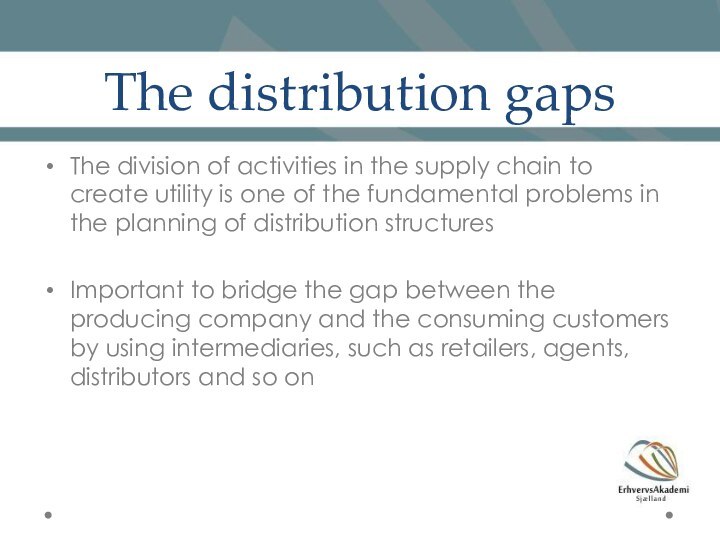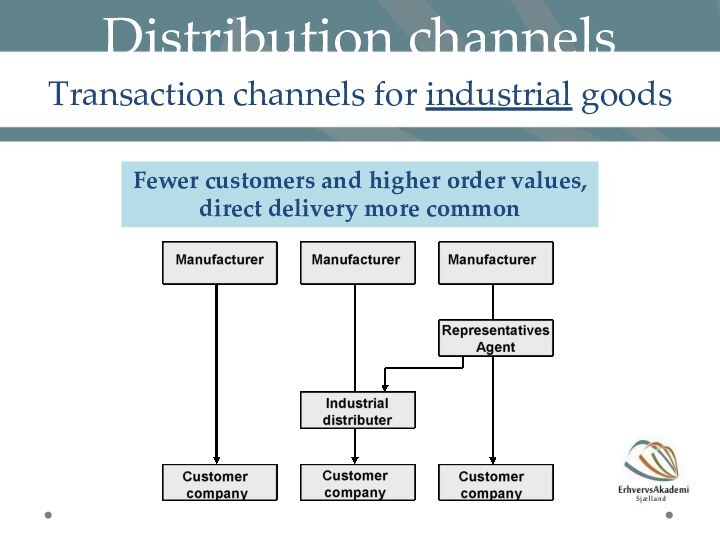Слайд 2
Definitions
Logistics: the science of the efficient flow of
materials.
That is; all the activities, which together ensure
that materials and products are at the right place at the right time, thus creating financial gain for the company
To create efficient logistics it is necessary to have both efficient end effective internal material flows between companies
Слайд 3
Definitions
Supply Chain Management: is used as a similar
concept, but emphasize the significance of integrating flows within
the individual company with other companies in the supply chain…
Supply Chain Management also encompasses the planning and management of all activities involved in logistics management, such as coordination and collaboration with suppliers, intermediaries, third-party service providers, and customers
Also, it involves more processes than just the logistics, such as product development, marketing and so on
Слайд 4
Logistics as a system
Logistics is an open system
that has en exchange with its surroundings – the
aim is to supply customers efficiently with their required products through different subsystems;
the material supply system; purpose is to supply production with raw materials and components
the production system; co-ordinates machines, personnel and materials to achieve an efficient production process
the distribution system; has a close relationship with the company’s overall market strategy, which originates in the market’s and customer’s needs, and determines what delivery service distribution must achieve
Слайд 6
Goals of logistics
The goal is to create competitiveness
and improve efficiency that positively affect profits by:
Creating good
customer service; flexible delivery service and information on material flows
Focusing on cost; avoid high warehouse costs, shortage costs, delay costs
Minimizing tied-up capital; capital (currents assets) involved in the flow of materials, such as raw materials, stocks in production and so forth
Слайд 7
Goals of logistics
The goal is to create competitiveness
and improve efficiency that positively affect profits by:
4. Flexibility
of the logistics system; has an impact on customer service, cost and tied-up capital
5. Focusing on TIME!
TTC: Time-to-customer
TTM: Time-to-market; from product concept to product launch, affects competitiveness
6. Minimizing environmental impact; through use of alternative vehicles, engines and fuels, flexible road transportation
Слайд 8
Exercise: Conflicting goals
Goal conflicts are not uncommon between
the marketing and production functions of a company. Identify
some of these conflicts and give examples of how they could be eliminated. (Table 1.1, p. 16-17)
Groups of 4-5 students
Prepare to present to the rest of the class
Time: 45 min.
Слайд 9
Distribution structures
Chapter 10
Distribution structure design and the role
of distribution for supply chain value adding
Слайд 10
Distribution utility values
Activities in a supply chain are
aimed at satisfying customers’ needs by supplying different types
of products. To achieve this, 4 types of utility must be performed in the supply chain:
Form utility – value refinement of input goods to end products
Place utility – available at the right place
Time utility – available at the right time
Ownership utility – transfer of ownership to customer
Marketing/sales – ownership
Production – form
Distribution – place and time
Слайд 11
Division of utilities
Division of utility-performing activities divided between
functions in a company*
But it can also be divided
between companies in the supply chain
*Example: IKEA
Place: customers fetch their goods themselves
Form: divided between IKEA and customers as customers assemble the goods themselves
Time: goods in stock and available at the warehouse
Ownership: transferred through cashier function in the warehouse
Слайд 12
The distribution gaps
The division of activities in the
supply chain to create utility is one of the
fundamental problems in the planning of distribution structures
Important to bridge the gap between the producing company and the consuming customers by using intermediaries, such as retailers, agents, distributors and so on
Слайд 13
Five gaps
Manufacturer vs. customer
Pace gap – different intervals
Distance
gap – few locations vs. widespread market
Quantity gap –
produce more than consumption
Range gap – wide product range is demanded – might be financially difficult
Variant gap – access to more variants
Слайд 14
The intermediary roles
Intermediaries are players that carry out
distribution functions between producers and consumers.
They are used
to achieve cost-efficient bridging of gaps. It is possible to identify 5 roles for intermediaries:
Aggregation role; delivers quantity according to each customer’s needs = place utility
Spreading role; stock-keeping intermediary, short delivery time = time utility
Contact & Service-providing role; direct customer support & order-specific configuration intermediary = ownership utility
Consolidation role; represents several companies and distribute their products = time & place utility
Слайд 15
Distribution channels
Transaction channels for consumer goods
Слайд 16
Distribution channels
Transaction channels for industrial goods
Fewer customers and
higher order values, direct delivery more common
Слайд 17
Customer Order Decoupling Point (CODP)
The point in the
supply chain from which a product is destined to
a certain customer
Material flows
CODP
Forecasts and plans
Specific cusomer orders
Слайд 18
Material flows in distribution channels
When the transaction channel
and the material flow channel are separated, there are
2 general alternatives:
Direct material flow channel: the intermediary may represent different suppliers at the same time of sale and ordering, and as such provide a type of one-stop shopping
Direct transaction channel: transaction channels initially going to the product-supplying company while the material flow channel goes from intermediary company to the customer
Слайд 19
Transaction and material flow channels
Слайд 20
Warehouse structures
When transaction channels and material flow channels
is handled by the company itself it is often
necessary in a distribution system to have a warehouse or a hierarchy of warehouses (central vs. regional)
There are pro’s and con’s of a centralized warehouse structure:
- Increased transportation costs
- Longer delivery times
- No local existence
- Longer proximity to customers
+ Economy of scale
+ Reduced bullwhip-effect
+ Reduces non-value activities
+ Reduced risk of incomplete
Слайд 21
eThe Bullwhip Effect
Demand variability increases as one moves
up the supply chain away from the retail customer,
and small changes in consumer demand can result in large variations in orders placed upstream.
Eventually, the network can oscillate in very large swings as each organization in the supply chain seeks to solve the problem from its own perspective. This phenomenon is known as the bullwhip effect and has been observed across most industries, resulting in increased cost and poorer service.
Слайд 23
The Bullwhip Effect
http://www.youtube.com/watch?v=wLNdDSYqhNw
Слайд 24
How should companies decide on the degree of
centralization?
The relationship between logistics costs and the degree of
centralization
Слайд 25
Changing conditions for intermediaries
During the past decade the
existence and value of intermediaries has been questioned
Different forms
of intermediaries have been eliminated as distribution systems have become more efficient (disintermediation), mainly because of developments in the area of IT























































